Featured Articles
- 01 What Is NTFS File System
- 02 What Is exFAT Format
- 03 What Is FAT File System Format (FAT, FAT16, FAT32)
- 04 What Is EXT2/3/4 File System (Linux) Format
- 05 NTFS VS exFAT VS FAT32, What's the Difference
- 06 How to Change File System to NTFS, FAT32, EXT
- 07 How to Convert File System - NTFS to FAT32
- 08 Best FAT32 Converter Free Download
- 09 Troubleshoot File System Errors
- 10 Fix File Is Too Large for Destination File System
- 11 Fix Volume Does Not Contain A Recognized File System
"The volume does not contain a recognized file system" is an error indicating your system can't read the file system on a storage device (like a USB or hard drive). This often happens due to corruption, improper ejecting, or formatting issues. Usually, you can fix this error with CHKDSK and formatting. It's recommended to use professional data recovery software to restore data from your error disk first.
Follow this table to take the correct processes to fix the "The volume does not contain a recognized file system" error without data loss:
| Workable Solutions | Step-by-step Troubleshooting |
|---|---|
| ✅Procedure 1. Recover Data from the USB or SD Card | First, use a powerful RAW recovery solution - EaseUS file recovery software to recover data from a USB drive or SD card volume that does not contain a recognized file system...Full steps |
| 🔨Procedure 2. Fix and Repair the Disk by Formatting | After restoring data from the hard drive that is not accessible or cannot be recognized, you can now repair and fix it by formatting in Disk Management...Full steps |
| 📌Procedure 3. Copy the Files Back to the SD Card/USB | After formatting your removable disk, you can open it and use it for data storage again. You can copy the files you recovered back to your external hard drive...Full steps |
How to Fix 'The Volume Does Not Contain a Recognized File System'
I am getting the error, "The volume does not contain a recognized file system," while formatting a pen drive. How can I fix this? - from Quora
Common Symptoms of The Volume Does Not Contain a Recognized File System
Sometimes, when you plug in an external hard drive, USB flash drive, SD card, or some other storage device into your Windows computer, Windows prompts, "You need to format the disk in drive G: before you can use it. Do you want to format it?"
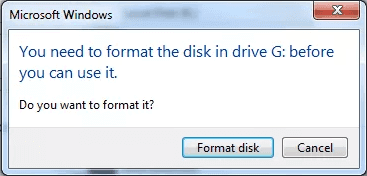
You might click Cancel to refuse to format the disk or card if there are some important data files. Then Windows will prompt drive is not accessible with the notice, "Drive G:\ is not accessible. The volume does not contain a recognized file system. Please ensure all required file system drivers are loaded and the volume is not corrupted." This is how the "The volume does not contain a recognized file system" error usually occurs in Windows 11 or Windows 10.
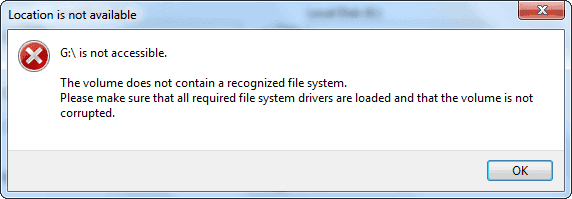
If your drive becomes RAW or you have accidentally clicked the "Format disk" button and lost everything on your USB or other disks, try to use EaseUS Data Recovery Wizard to perform RAW drive recovery and bring back important files now! Also, it's recommended to recover data before fixing this error with CHKDSK or other methods.
Causes of This Volume Do Not Contain Error Code
To fix "The volume does not contain a recognized file system" error in Windows without losing data, you should first figure out why this error happens. Why did you receive the error message?
As we know, the most likely reason is a file system error. A file system error on your device can cause it to become a RAW drive, which is not a type of file system but rather a problem with your drive. It typically occurs when the file system type information is missing or inconsistent between several system tables. Simply speaking, the file system errors that may lead to the issue in the discussion include
- Your computer does not recognize the file system of your storage device.
- The file system of your device is missing.
- Your device is not correctly formatted, or the file system is damaged.
How to Solve The Volume Does Not Contain a Recognized File System Issue
Except for formatting the RAW volume, other ways you can try to troubleshoot are
| Methods | Editor's Review |
| ♻️Run SFC scan | System File Checker is a Windows default troubleshooting utility that you can use to scan and repair corrupted system files. |
| 🔌Check disk error | To fix the error on your hard drive, you can connect it to your computer. Go to This PC, right-click the drive, and click Properties. Select Tools and click Check to scan the drive. |
| 📈Run CHKDSK Command | The CHKDSK command can find the file system corruption and fix it to make your computer able to recognize the volume. But if the CHKDSK fails and prompts that the file system is RAW, you should try other methods. |
| 💽Convert RAW to NTFS | If the volume does not contain a recognized file system showing RAW, you can convert the RAW drive to NTFS to make it work again. |
Such errors will happen if you have ever forcibly unplugged your external hard drive from the computer without "safely removing" it first. After figuring out what results in the "The volume does not contain a recognized file system" error, fixing it without data loss becomes quite easy.
Now do you know the cause and manifestation of this problem? If you're interested, you can share it on your social media.
Fix "The Volume Does Not Contain a Recognized File System" Error Without Losing Data (3 Steps)
The most effective way to fix file system-related issues is to format the storage device. By formatting, you will assign a new file system to the device, which will make the device usable again. However, since formatting will erase all the existing files on your hard drive, you will need to perform data recovery before the fix if you don't want to lose them all. Therefore, to fix an external storage device that has file system errors, all you need to do is to:
- 1️⃣First, find a reliable data recovery tool to restore files from RAW drive
- 2️⃣Second, format the hard drive/USB/SD card
- 3️⃣Finally, copy the recovered data back to the device
Step1. Recover Data From Raw Drive with "The Volume Does Not Contain a Recognized File System" Error
Offering a powerful and easy RAW recovery solution, EaseUS Data Recovery Wizard allows you to recover your data from the RAW drive before or after formatting the device.
It is a proven way to solve the "Drive is not accessible. The volume does not contain a recognized file system" issue in Windows 11/10/8/7/Vista/XP and Windows Server 2012/2008/2003.
With EaseUS data recovery software, you can easily recover formatted hard drives and even RAW drives. It can help you scan the whole disk and find recoverable photos, videos, documents, and audio files. Check the following tutorial and recover data from your disk:
Step 1. Select a drive and start scanning
Launch EaseUS Data Recovery Wizard and hover over the partition where you lost data. This could be an internal hard disk, external disk, USB, or SD card. Then, click "Search for Lost Data".
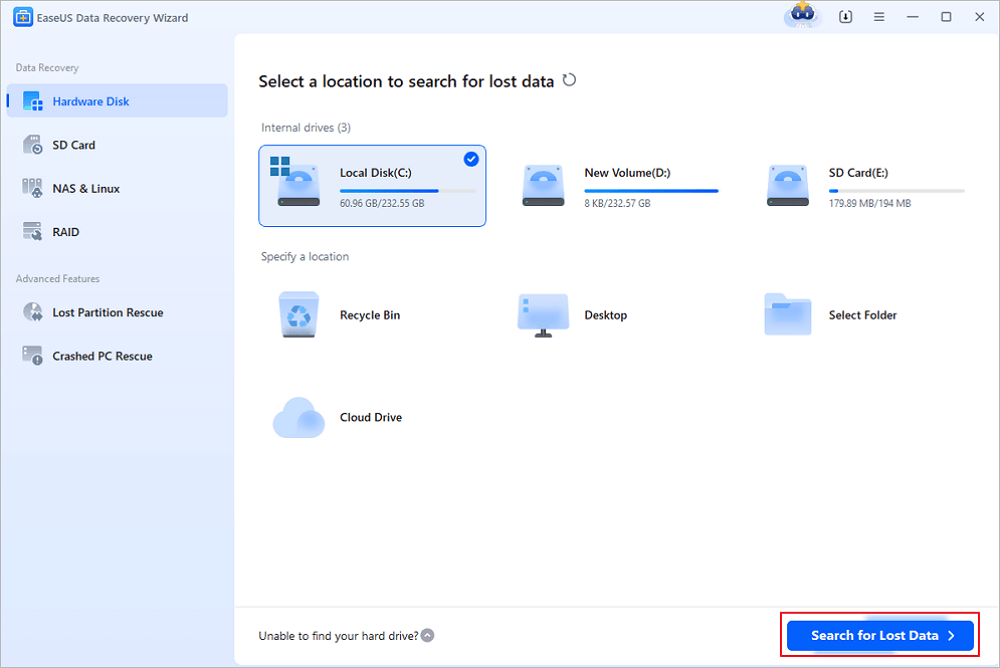
Step 2. Check and preview scanned files
Use the file format filter on the left or upper right corner to narrow the scan results until you find the files you need. Then, you can click the "Preview" button or double-click a file to preview its content, if you'd like.
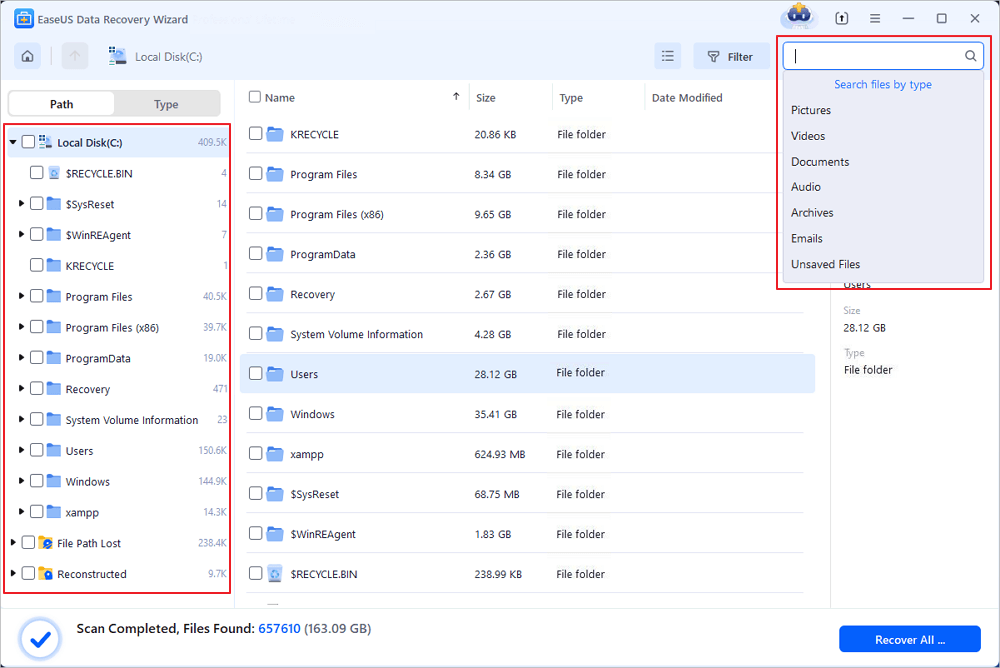
Step 3. Recover lost data to a secure location
Click the checkbox next to the file and click "Recover" to restore the lost data to your local storage or Cloud drive. We recommend that you do not store the recovered data on the disk where you lost it earlier.
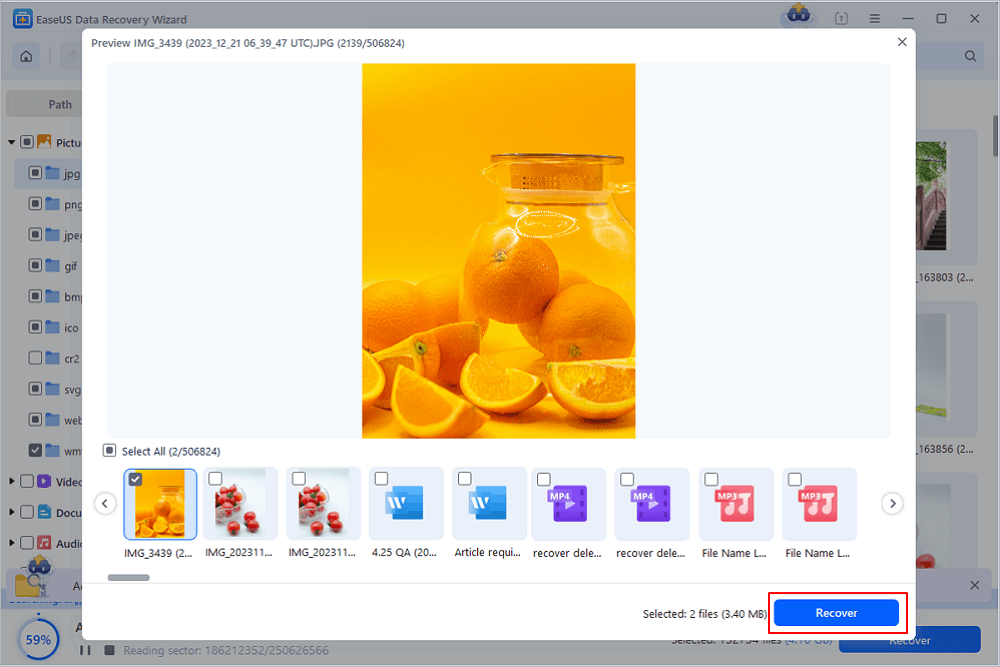
Many users who have encountered this error recovered files with EaseUS Data Recovery Wizard:
| 📒Reviews |
|
In addition to data recovery solutions, we still provide data recovery services to help you retrieve data from a RAW USB or RAW SD card on a one-to-one basis.
Consult with EaseUS Data Recovery Experts for one-on-one manual recovery service. We could offer the following services after FREE diagnosis:
- Repair damaged RAW drive without formatting
- Recover data from RAW drives, including BitLocker encrypted drives
- Recover RAW partition, RAW USB, RAW flash drive, RAW external hard drive, etc.
Step 2. Fix and Repair USB/SD Card with RAW File System
After restoring data from devices that are not accessible or cannot be recognized, you can now follow the below steps to repair and fix devices such as external hard drives, USB drives, SD cards or hard drive partitions, and repair the file system to be recognizable/detectable again:
Step 1. Right-click "This PC"/"My Computer" > "Manage" > "Disk Management".
Step 2. Right-click on the RAW drive, USB, SD card... > format volume" > reset file system (NTFS/FAT32, etc.) and rename the device.

Step 3. Click "Finish" to complete 'the volume does not contain a recognized file system' error repair process on storage devices.
Step 3. Copy the Files Back to Your Storage Device
After formatting your removable disk, you can open it and use it for data storage again. You can copy the files you recovered back to your external hard drive, USB, memory card... to make it just like before.
Share these very practical solutions to help more people.
The Bottom Line
If there is no data on the external storage device or you don't want to keep the files on it, you can format the device directly to remove the error message "The volume does not contain a recognized file system."
But if you don't want to lose any item, you are highly recommended to retrieve the data first before the formatting. Although EaseUS data recovery software supports formatted data recovery, it's always better to rescue your files before the operation.
Volume Does Not Contain a Recognized File System FAQs
Next are some questions that people also ask. To utterly remove the error "the volume does not contain a recognized file system", the answers might be useful for you.
How to fix this volume does not contain a recognized file system?
Method to fix this volume does not contain a recognized file system:
- Run SFC scan
- Use disk check utility
- Run CHKDSK command
- Format the RAW drive
What does the volume does not contain a recognized file system D drive?
When you try to access a removable device on your computer, you may receive an error message that says " X:\ is not accessible. The volume does not contain a recognized file system. Please ensure all required file system drivers are loaded and the volume is not corrupted."
This error may occur for bad sectors on the drive, file system damage, corrupted system files, or RAW USB or SD card.
How do I fix a raw USB?
Use CMD to fix and repair a RAW USB drive or SD card:
Step 1. Search for Command Prompt and run it as administrator.
Step 2. Type chkdsk G: /f in the CMD window and hit "Enter". (Replace "G" with the drive letter of your USB flash drive)
Step 3. Then Windows will start checking RAW USB and fixing the damaged file system.
How do I open a raw drive without formatting?
To open and access a raw drive without formatting, you can:
Step 1. Go to "This PC" on your Windows 10 or Windows 11 computer.
Step 2. Right-click the RAW drive and click "Properties".
Step 3. Click the "Tools" tab and then click "Check".
Step 4. In the "Error Checking" window, click "Scan and repair drive" and wait for the process to finish.
Was This Page Helpful?
Dany is an editor of EaseUS who lives and works in Chengdu, China. She focuses on writing articles about data recovery on Mac devices and PCs. She is devoted to improving her writing skills and enriching her professional knowledge. Dany also enjoys reading detective novels in her spare time.
Approved by Evan Galasso
Evan Galasso is a digital forensics and data recovery engineer with over 10 years of experience in the field. He presents opinions on the current state of storage media, reverse engineering of storage systems and firmware, and electro-mechanical systems of SSDs and HDDs.
Related Articles
-
How to Recover Permanently Deleted Files in Windows 11 [Top Methods]
![author icon]() Brithny/Dec 12, 2025
Brithny/Dec 12, 2025 -
Fix Error 0x800700e1: Operation Did Not Complete Because of a Virus
![author icon]() Jaden/Dec 12, 2025
Jaden/Dec 12, 2025 -
How to Recover Windows File Specific Folder
![author icon]() Tracy King/Dec 12, 2025
Tracy King/Dec 12, 2025 -
How to Recover Permanently Deleted Files/Videos/Photos
![author icon]() Tracy King/Dec 12, 2025
Tracy King/Dec 12, 2025

